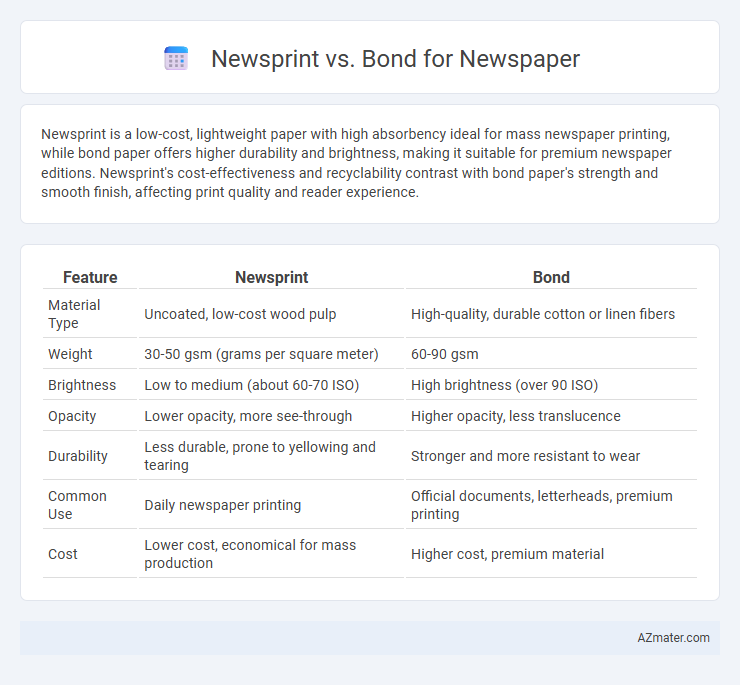Newsprint is a low-cost, lightweight paper with high absorbency ideal for mass newspaper printing, while bond paper offers higher durability and brightness, making it suitable for premium newspaper editions. Newsprint's cost-effectiveness and recyclability contrast with bond paper's strength and smooth finish, affecting print quality and reader experience.
Table of Comparison
| Feature | Newsprint | Bond |
|---|---|---|
| Material Type | Uncoated, low-cost wood pulp | High-quality, durable cotton or linen fibers |
| Weight | 30-50 gsm (grams per square meter) | 60-90 gsm |
| Brightness | Low to medium (about 60-70 ISO) | High brightness (over 90 ISO) |
| Opacity | Lower opacity, more see-through | Higher opacity, less translucence |
| Durability | Less durable, prone to yellowing and tearing | Stronger and more resistant to wear |
| Common Use | Daily newspaper printing | Official documents, letterheads, premium printing |
| Cost | Lower cost, economical for mass production | Higher cost, premium material |
Introduction: Understanding Newsprint and Bond Paper
Newsprint is a lightweight, low-cost paper primarily used for printing newspapers, characterized by its high porosity and relatively rough texture. Bond paper, generally heavier and more durable, is often utilized for formal documents and publications requiring higher print quality and longevity. Comparing their properties, newsprint's inexpensive and absorbent nature suits mass circulation, while bond paper offers superior strength and crispness, impacting the overall presentation of printed newspapers.
Key Differences Between Newsprint and Bond Paper
Newsprint is a low-cost, lightweight paper primarily used for printing newspapers, known for its high absorbency and quick ink drying, while bond paper is thicker, more durable, and often used for official documents and high-quality prints. Newsprint typically has a rough texture and lower brightness, making it less suitable for long-term archival, whereas bond paper offers a smoother finish and higher brightness, enhancing print clarity and longevity. The key differences lie in their composition, cost, durability, and intended usage, with newsprint favoring mass production and economy, and bond paper prioritizing quality and archival stability.
Paper Composition and Manufacturing Processes
Newsprint is primarily made from wood pulp with a high proportion of mechanical pulp, resulting in a rougher texture and lower brightness, optimized for cost-effective mass printing of newspapers. Bond paper, typically composed of higher-quality cotton or linen fibers blended with wood pulp, undergoes a more intensive bleaching and refining process, yielding a smoother, stronger surface suited for premium print media like business stationery. The manufacturing of newsprint emphasizes speed and volume with less refining, while bond paper production involves extended pulping, bleaching, and calendering to enhance durability and print quality.
Print Quality: Clarity and Color Reproduction
Newsprint offers a cost-effective solution for newspapers but often compromises print quality with lower clarity and muted color reproduction due to its coarse texture and high absorbency. Bond paper provides sharper text definition and more vibrant color output, attributed to its smoother surface and higher brightness, enhancing overall readability and visual appeal. Choosing bond improves the newspaper's visual impact, making images and typography stand out more distinctly.
Cost Comparison: Budget Considerations
Newsprint is significantly more cost-effective than bond paper, making it the preferred choice for high-volume newspaper production due to its lower price per pound and economical manufacturing process. Bond paper, while offering higher quality and durability, comes at a substantially higher cost, increasing overall printing expenses which may not be justifiable for mass-distributed newspapers. Budget-conscious publishers prioritize newsprint to minimize production costs while maintaining acceptable print quality and reader satisfaction.
Environmental Impact and Sustainability
Newsprint, primarily composed of recycled fibers and produced with lower energy consumption, typically offers a more sustainable option for newspapers compared to bond paper, which is often made from higher-grade virgin pulp requiring greater resource input. The environmental impact of newsprint is reduced by its recyclability and the use of soy-based inks, resulting in lower carbon emissions and less toxic waste. Bond paper's durability and brightness come at the cost of increased water usage and chemical treatments, leading to a larger ecological footprint in mass newspaper production.
Durability: Handling and Longevity
Newsprint, widely used for newspapers, offers cost-effectiveness but compromises on durability due to its low tear resistance and rapid yellowing, leading to shorter lifespan during handling. Bond paper, with higher fiber content and strength, enhances durability by resisting tears and maintaining integrity longer under frequent handling and exposure to light. This makes bond paper a preferable choice for editions requiring better longevity and quality preservation.
Reader Experience: Texture and Legibility
Newsprint offers a coarse, lightweight texture that enhances tactile engagement but may compromise sharpness in text, affecting legibility under varying light conditions. Bond paper provides a smoother, denser surface, delivering clearer print quality and improved readability, particularly for smaller fonts and detailed images. Reader experience is optimized with bond paper due to its resistance to ink bleed and better contrast, ensuring consistent clarity throughout prolonged reading sessions.
Industry Preferences and Common Uses
Newspaper publishers predominantly favor newsprint due to its cost-effectiveness and suitability for high-speed printing presses, ensuring efficient mass production. Bond paper is less common in newspaper printing but is preferred for inserts, specialty sections, or flyers requiring superior durability and print quality. Industry trends indicate that newsprint remains the standard for bulk newspaper content, while bond paper serves niche applications demanding enhanced appearance and strength.
Conclusion: Choosing the Right Paper for Newspapers
Newsprint offers cost-effective printing with moderate durability, making it ideal for daily newspapers focused on high circulation and rapid production. Bond paper provides higher quality, better opacity, and smoother finish, suitable for premium newspapers or inserts requiring superior print clarity. Choosing the right paper depends on balancing budget constraints, print quality demands, and the newspaper's target audience.

Infographic: Newsprint vs Bond for Newspaper
 azmater.com
azmater.com